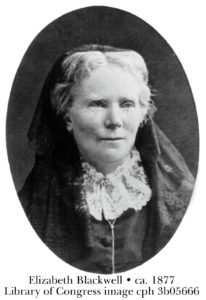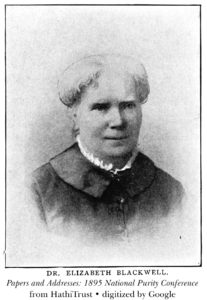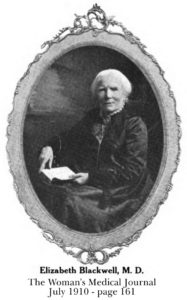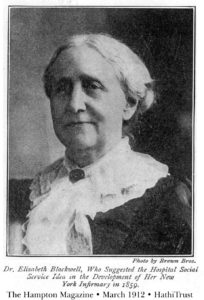
Elizabeth Blackwell (February 23, 1821-May 31, 1910) was the first woman to earn a degree from medical school in the United States and the first woman to appear on the medical registry of the United Kingdom. Blackwell was also instrumental in opening the medical profession to other women through a distinctive combination of managerial and social vision. She lectured widely and published several works on medical practice, medical advice, medical ethics, and modern morality.
Born into a politically liberal yet socially conservative Independent Congregationalist family in Bristol, England, Elizabeth was the third of nine surviving children of Samuel and Hannah Blackwell. The Blackwell girls had a governess to supply their education, and Elizabeth developed a love of reading at a young age. In her autobiography, Blackwell also claims a “vivid remembrance” of her early childhood social activities at the Reverend John Leifchild’s Bridge Street congregation in Bristol. She notes her father’s ardent opposition to the Established Church of England, which he denounced as “rags of Popery.”
Elizabeth Blackwell and her family were ardently opposed to slavery, even though Samuel Blackwell, one of Bristol’s leading businessmen, was a refiner of slave-produced sugar. The Blackwell children took it upon themselves to give up sugar consumption, an antislavery strategy that was practiced widely. In later years, Samuel Blackwell himself would come to regard his business relations with Cuban sugar planters as inconsistent with his antislavery beliefs. He would thereafter seek alternative means of sourcing sugar.
Samuel Blackwell’s Bristol factory burned down in 1828, leaving the family in financial difficulty. They immigrated to New York City four years later, in the hopes of finding economic opportunity, but also greater religious freedom and a less stifling social and political environment. The Blackwells first rented a house in Manhattan. Three years later they relocated to the countryside of Long Island, and Elizabeth and the older girls commuted into Manhattan for school. It was on Long Island that Samuel Blackwell contracted the case of malaria that permanently affected his health. To escape the malarial swamps, the family relocated once again to Jersey City.
In New York, Elizabeth and her family joined the Presbyterian Church of the Reverend Samuel Cox, a founder of New York University and an abolitionist. Elizabeth also sampled a number of New York churches and attended the revivalist sermons of Charles Grandison Finney, later president of Oberlin College. A leading evangelist of the Second Great Awakening, Finney preached abolition and equality of the sexes. Elizabeth’s New York religious exploration was often tied to her family’s anti-slavery beliefs. Attending lectures and sermons was also Elizabeth’s chief form of education and entertainment. In her diary, Elizabeth wrote of the abolitionist lectures of her father’s friend William Lloyd Garrison, to whose newspaper, The Liberator, Samuel Blackwell contributed.
The family’s deepening involvement in abolitionism in America, coupled with the loss of the New York sugar refinery, again to fire, solidified Samuel’s determination to seek an innovative means of producing sugar. He began planning to grow sugar beets as an alternative to slave-produced sugar cane.
In 1838, the Blackwells moved to Cincinnati, Ohio, in order to undertake the beet-sugar business and farming enterprise. However, Samuel Blackwell, whose constitution had been weakened by his struggle with malaria, died unexpectedly soon after the move. Without a means of financial support, the elder Blackwell daughters immediately opened a school for girls, while the boys looked for other forms of employment.
In Cincinnati, Elizabeth Blackwell visited a number of churches, including Lyman Beecher’s evangelical Presbyterian church. The Blackwells became friendly with the Beecher clan, and Elizabeth grew close to Harriet Beecher, later Stowe. Much to her mother’s dismay, however, Elizabeth was confirmed in the Episcopal Church.
Soon thereafter, in 1839, Blackwell rode the wave of Unitarianism that swept over Cincinnati, she was drawn to the church of the newly ordained and installed William Henry Channing, nephew to William Ellery Channing. The younger Channing had a profound and lifelong effect on Blackwell. Through him, she was drawn to Transcendentalism and the writings of Ralph Waldo Emerson and Margaret Fuller.
Because of their affiliation with Channing’s Unitarianism, the Blackwell sisters’ school began to lose its students and eventually closed in 1843. Elizabeth soon took a teaching post in Henderson, Kentucky, where she witnessed, and was disturbed by, the slave economy. She resigned after the first term and returned home.

The plan to become a doctor began to take shape in 1845. Blackwell’s determination to pursue medicine brought with it something like missionary zeal and moral purpose, as her writings make clear. In her autobiography, Blackwell recalls that she began considering a medical career at this time after a dying female friend claimed that “If I could have been treated by a lady doctor, my worst sufferings would have been spared me.”
Also in 1845, Margaret Fuller published Woman in the Nineteenth Century. Emerson’s “Self-Reliance” had been published four years earlier, in 1841. The nonconformism, individualism, and feminism of these texts would have bestowed upon Blackwell’s unconventional plans something like Biblical authority. It was also around this time that Channing and Blackwell’s sister Anna became involved in the women’s rights movement and were drawn to the largely Unitarian utopian community of Brook Farm.
There were, then, social and philosophical movements afoot that gave context to Blackwell’s resolution to become a physician rather than a nurse. Blackwell wanted an intellectual challenge as well as financial and social independence, and she thought she could overcome the fact that “I hated everything connected with the body, and could not bear the sight of a medical book.” Her plan to become a doctor endured, despite the fact that most of her friends and advisors found the idea impractical.
A year later, in 1846, Blackwell accepted a position as a music teacher in Asheville, North Carolina, at the Female Academy, directed by a physician turned Presbyterian minister, the Reverend Dr. John Dickson. In North Carolina, Blackwell briefly undertook—illegally—to teach Sunday school for the enslaved African American population. While she was not comfortable socially among whites in a slave-owning town, she did appreciate that Dr. Dickson allowed her to study his medical books, and he encouraged her ambition to become a doctor.
When the Asheville academy closed, Blackwell accepted an invitation to stay with Reverend Dickson’s younger brother, Dr. Samuel Dickson, in Charleston, South Carolina. The younger Dr. Dickson was an eminent physician and professor of medicine. He was also a rationalist Unitarian. Samuel Dickson found Blackwell a position at a girls’ boarding school, and he encouraged her private medical study in his library.
In 1847, Blackwell left Charleston for Philadelphia, in hopes of gaining access to a local medical college. She boarded with the physician William Elder and his wife, who encouraged her medical pursuits and who followed the same Associationist principles that had drawn Anna Blackwell and Henry Channing to Brook Farm. While Blackwell did find several Philadelphia physicians who helped to foster her private pursuit of medicine, she did not gain access to any of the medical schools to which she first applied.
Eventually, in October 1847, Blackwell was admitted to the Geneva Medical College in upstate New York. Accompanied by a recommendation from an eminent Philadelphia physician, Blackwell’s application was taken seriously. Her actual admission, however, was the inadvertent result of a unanimous vote in her favor by the male students, who regarded the opportunity to vote on the admission of a woman as a cause for mischief.
Blackwell enrolled a month later. She was a serious and successful student who appears to have had a sobering effect on her male colleagues. In 1848, she completed a medical internship at the Blockley Almshouse in Philadelphia, where she conducted her study of typhus, or “ship fever,” based in the numerous cases she treated among Irish immigrants. This research was the subject of her medical school thesis, which was later published. She graduated from medical school in January 1849.
Later that year, shortly after taking American citizenship, Blackwell sailed for Great Britain. In London, after attending a gathering with several Unitarians, she recorded in her journal: “It really is absurd to say the Unitarians’ faith is nothing but negative. Here under its influence, is just such a party assembled as I have met with so much pleasure in the days of yore. A little less Transcendentalist certainly and a little more style but still the same spirit.”
Blackwell then journeyed to Paris to pursue the advanced study of medicine. She found an internship at La Maternité, the “lying-in” hospital for childbirth and infant care. Despite her medical degree, she was required to live in the dormitories with, and pursue the same course of study as, the young women being trained as midwives.

It was during her work in Paris that Blackwell lost the sight in her left eye. She had been cleaning with a syringe the eye of a baby who had purulent ophthalmia, a form of bacterial conjunctivitis caused by the mother’s transmission of gonorrhea to the infant during childbirth. The liquid splashed into her own eye, which became infected. She sought a cure at a hydropathy spa in Germany, without success. Later, her eye was surgically removed. The loss of her eye effectively put an end to any consideration that Blackwell had of a career as a surgeon.
In 1850, Blackwell pursued further advanced studies in medicine at London’s St. Bartholomew’s hospital. While in residence, she paid a visit to her childhood minister, the now elderly Reverend Leifchild who had relocated from Bristol to a London congregation decades earlier. In a letter home, she let her family know that Leifchild “distinctly remember[ed]” her christening. She also reported that word of her “Socinian” affiliation—a reference to the Unitarian faith she had embraced as a teenager—had made its way to Leifchild. Blackwell was obliged to explain her faith: “Of course I spoke up for myself. I told him my religion was certainly a little peculiar; but nevertheless it was a very good and indeed very strong one—and he didn’t seem much troubled about the state of my soul; indeed, I believe that, on the whole, he considered that it was a little safer than most of the ladies’ of his acquaintance!” (Blackwell letter of November 1, 1850).
While her sisters and Channing were attending the first National Women’s Rights Convention in Worcester, Massachusetts, Blackwell was meeting remarkable women in London whose friendship and collegiality would have a profound effect on her. Her new friends Barbara Leigh Smith, later Bodichon, and Bessie Rayner Parkes, later Belloc, were leading women’s rights advocates, and both were from important Unitarian families. Parkes was the great-granddaughter of Joseph Priestley, and the mother of Hilaire Belloc. Bodichon was related to the Bonham-Carter family and a first cousin to Florence Nightingale. Through Bodichon, Blackwell became acquainted with the novelist George Eliot and the philanthropist Lady Noel Byron, widow to the poet. Lady Byron, in turn, introduced her to the celebrated actress Fanny Kemble.
Blackwell met Florence Nightingale in November 1850 and visited her family’s country estate several months later. Although Nightingale had not yet embarked on her nursing career, she and Blackwell entertained the idea of working together to create a hospital. As Blackwell recorded in her autobiography: “She said she should be perfectly happy working with me, she said she should want no other husband.” In later years they would have a professional rift over the role of women in medicine and the direction of the profession, but she still attributed to Nightingale her sense “that sanitation is the supreme goal of medicine.”
After six months at St. Bartholomew’s in London, Blackwell returned to New York to open a medical practice. At first she struggled to gain patients, but eventually, in 1853, she and her sister Emily opened a clinic with limited services, The New York Dispensary for Poor Women and Children. Emily was herself enrolled in medical school at Western Reserve University in Ohio. The sisters were joined by Marie Zackrzewska, who had served as chief midwife and professor at the midwifery training hospital in Berlin. Zackrzewska would go on to earn a medical degree from Western Reserve in 1856.
During this period, Blackwell was socially isolated, and she wanted someone to do domestic chores in her home. She decided to adopt a child in an era when adoption still retained characteristics of indentured servitude. At the orphanage, she selected a seven-year-old Irish girl, Catherine (“Kitty”) Barry. Barry remained a devoted daughter and servant for the remainder of Blackwell’s life.
While none of the five Blackwell sisters married, both Emily and Ellen also adopted children. Two of the four Blackwell brothers married remarkable women: Samuel Charles married Antoinette Brown, the first woman ordained as a minister in the United States; Henry married Lucy Stone, a prominent women’s rights orator and abolitionist.

In 1857, Blackwell opened a hospital, The New York Infirmary for Indigent Women and Children. Her sister Emily and Marie Zackrzewska were on the staff. In addition to serving medical and surgical patients, the hospital was a training facility for women wishing to pursue careers in medicine. A year later, Blackwell returned to England to explore the possibility of opening a similar hospital in London. Although the hospital plan did not come to fruition, Blackwell did become the first woman recognized on the British Medical Register.
Blackwell returned to America in 1859. At the outbreak of the Civil War, she gathered a group of prominent women in New York to consider a role for women in the war effort, and she established the Women’s Central Relief Association, an umbrella organization for women’s volunteer work. Blackwell was passed over for distinction during the war when the social reformer Dorothea Dix, who had no medical training, was appointed Superintendent of Army Nurses. In 1864, however, Blackwell did have an audience with Abraham Lincoln.
In 1869, Blackwell returned to England and lived there for the remainder of her life, although she travelled throughout Europe in her later years. Much of her career at this time was dedicated to social reform and to writing and lecturing. Her chief interests included medical ethics and social morality: she was opposed to the new developments in germ theory and the practices of vivisection, inoculation, and contraception. Instead, she championed hygiene, disease prevention, and personal morality as the foundation of modern medicine. She was also a vocal opponent of the regulation of prostitution through the Contagious Diseases Acts, as she believed the laws in effect condoned the sexual trafficking that she wished to see abolished.
In her later years, Blackwell was not affiliated with a particular religious denomination, but she continued to attend church services and became a spokesperson for the Christian Socialist movement. She embraced progressive Christian ideals of justice, mercy, and universal brotherhood. Departing from the views held by many in the medical profession at the time, she argued that a belief in Christ, whom she viewed as “the Great Teacher,” was consistent with science.
In 1890, she was drawn to the newly founded Christo-Theosophical Movement, whose proponents saw it as a counterpart to the Theosophical Society of Madame Blavatsky. Blackwell was attracted less to exploring the esotericism of the movement than to fostering enlightenment and wisdom through humanity’s global interconnectedness. Throughout her final years, Blackwell spoke on behalf of her spiritual and moral visions, which she believed complemented her medical ethics.
Death
Elizabeth Blackwell died on May 31, 1910, age 89, at her home in Hastings, England. She was buried in Kilmun, Scotland.
Sources
In 2015, Harvard University in Cambridge, Massachusetts completed the two-year project to digitize the Schlesinger Library collection of the Blackwell Family Papers; they are available online at schlesinger.radcliffe.harvard.edu/onlinecollections/blackwell/. Noteworthy biographies of Blackwell and her family include Elinor Rice Hays, Those Extraordinary Blackwells: The Story of a Journey to a Better World (1967); Nancy A. Sahli, Elizabeth Blackwell: MD 1821-1910 (1981); and Julia Boyd, The Excellent Doctor Blackwell: The Life of the First Woman Physician (2013). Early Blackwell biographies are found in Phebe A. Hanaford, Daughters of America; or, Women of the Century (1882), and in Frances Willard & Mary Livermore, American Women: Fifteen Hundred Biographies: Volume I (1897). Internet resources include the “Blackwell Family” website hosted by Radcliffe/Harvard’s Schlesinger Library and the “Elizabeth Blackwell, America’s First Woman M.D.” online exhibit hosted by the U.S. National Library of Medicine of the National Institute of Health (NIH). The Upstate Medical University Health Sciences Library in Syracuse, New York hosts an Elizabeth Blackwell biography, bibliography, and downloadable Adobe Acrobat PDF files for six of her books.
Elizabeth Blackwell’s autobiography is Pioneer Work in Opening the Medical Profession to Women (1895). Her meditations on religion, medicine, and society include The Laws of Life, with Special Reference to the Physical Education of Girls (1852); “The Religion of Health” (1869); “How to Keep a Household in Health: An Address” (1870); Counsel to Parents on the Moral Education of their Children in Relation to Sex (1879); “Medicine and Morality” (1881); “Christian Socialism: Thoughts Suggested by the Easter Season” (1882); “Christianity in Medicine” (1890); and two volumes of collected writings, Essays in Medical Sociology (1902).
Article by Carol Howard
Posted August 20, 2018